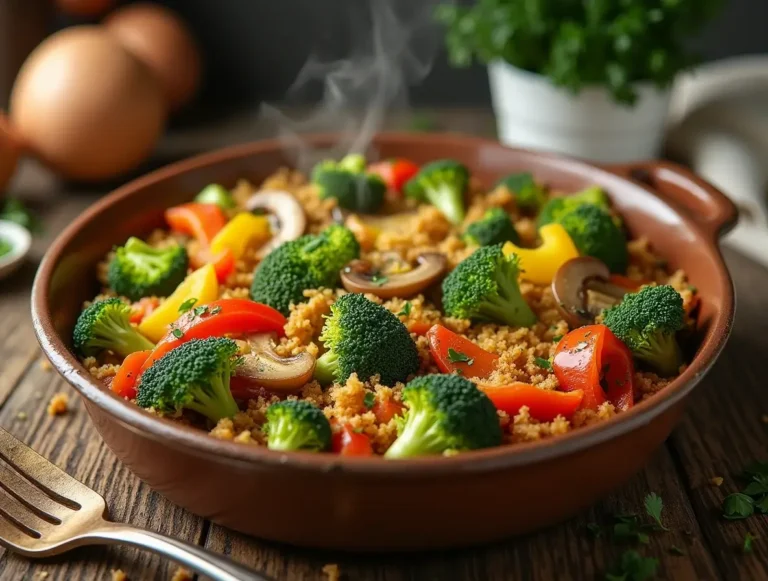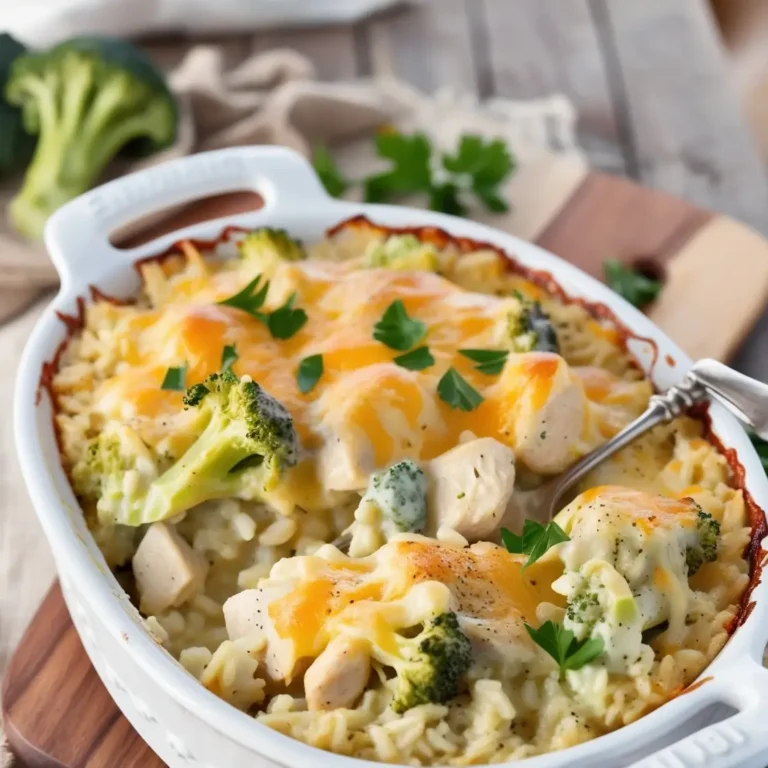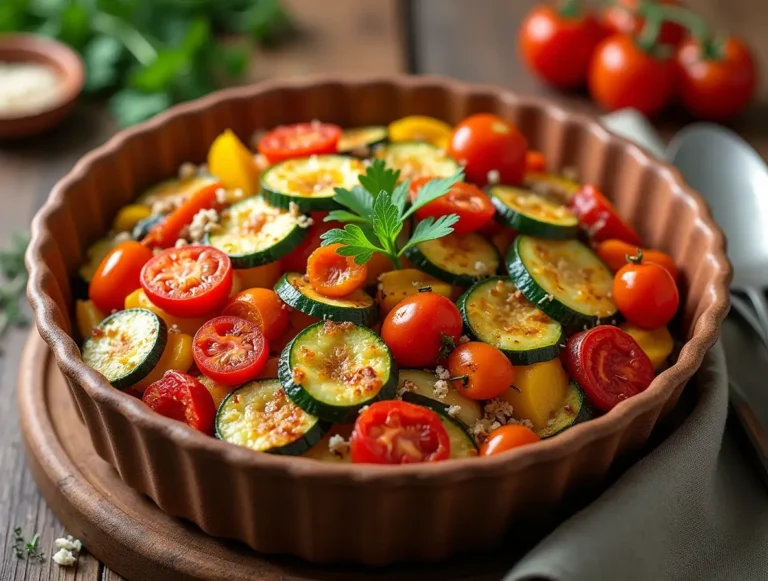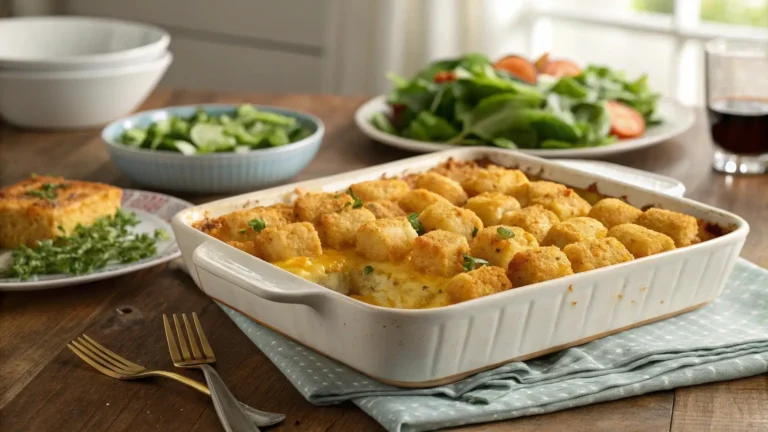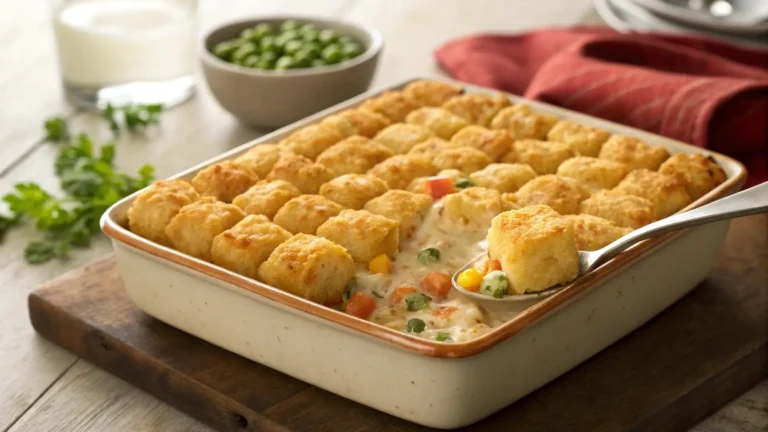Low-Calorie Vegetable Casserole Recipes for Healthy Living
Finding healthy meals can be tough. But, low-calorie vegetable casseroles changed the game for me. They’re a key part of my healthy lifestyle, and I’m excited to share them with you.
These casseroles are full of fresh veggies, legumes, and whole grains. They’re a tasty and healthy way to feed your body. They’re perfect for anyone wanting to eat well, stay healthy, or enjoy comforting meals without the guilt.
This article has a range of recipes, from Southwestern quinoa casseroles to broccoli and cauliflower bakes. These dishes are not only delicious but also support your health goals. They’re packed with plant-based, fiber-rich ingredients that help you eat well and feel great.
Table of Contents
Understanding the Benefits of Low-Calorie Vegetable Casseroles
Adding nutritious baked vegetables to your meals through low-calorie casseroles is great for your health. These dishes are not only tasty and cozy but also packed with nutrients. They help keep you well and happy.
Nutritional Advantages of Vegetable-Based Dishes
Vegetable casseroles are full of fiber, vitamins, and minerals. For example, a cup of cauliflower has just 26 calories but gives you 5 grams of carbs, fiber, vitamins, and antioxidants. Green beans are also rich in folate, a key B vitamin. Choosing low-fat, veggie-based casseroles boosts your nutrient intake easily.
Weight Management and Portion Control Benefits
Using low-calorie vegetable casseroles for meal prep can change your health and fitness for the better. These dishes are full of veggies, which are low in calories but high in fiber. This makes you feel full longer. Plus, many recipes make lots of food, so you can have leftovers for easy, controlled portions all week.
Role in a Balanced Diet
Low-fat casseroles with various baked vegetables are key to a balanced diet. They help you get the daily recommended amount of veggies, as health experts suggest. Adding these casseroles to your meals supports your health and wellness goals.
“Incorporating vegetable casseroles into your diet supports overall health and helps meet nutritional goals while enjoying comforting, satisfying meals.”
Essential Ingredients for Healthy Casserole Making
Creating tasty and healthy casseroles starts with the right ingredients. Choose veggie-packed entrées by adding fresh veggies. Broccoli, cauliflower, spinach, and bell peppers are great. They add flavor and help with calorie-conscious cooking.
Proteins are key for a balanced casserole. Go for lean options like beans, lentils, or tofu. They make your dish hearty and guilt-free comfort food. Use whole grains like quinoa or brown rice for texture and nutrition.
For creaminess without extra calories, try low-fat dairy or plant-based milk. Season with herbs and spices for flavor. This way, you avoid too much salt or calories.
| Ingredient | Quantity |
|---|---|
| Whole wheat pasta | 5 oz (140g) |
| Zucchini | 12 oz (340g) |
| Button mushrooms | 8 oz (225g) |
| Cottage cheese | 9 oz (250g) |
| Yogurt | 1 cup (235 ml) |
| White cheddar cheese | 1.5 oz (40g) |
| Dry thyme | 1 teaspoon |
| Dry dill | 1 teaspoon |
| Parsley flakes | 1 teaspoon |
| Oregano | 1 teaspoon |
By choosing these ingredients, you can make veggie-packed entrées, calorie-conscious cooking, and guilt-free comfort food. These dishes will nourish you and please your taste buds.
https://www.youtube.com/watch?v=-x29n8-RjKE
Low-Calorie Vegetable Casserole Base Recipes
Discover the joy of vegetables with these low-calorie casserole recipes. They are tasty and good for you. From a Mediterranean-style bake to a classic broccoli and cauliflower mix, these dishes are perfect for health lovers.
Mediterranean-Style Vegetable Bake
This vibrant casserole is filled with roasted veggies like zucchini, onions, and bell peppers. It’s mixed with herbs and feta cheese. It has only 339 calories per serving, making it a guilt-free treat. It serves 6 and takes 10 minutes to prepare, then bakes for an hour.
Classic Broccoli and Cauliflower Casserole
Try our Classic Broccoli and Cauliflower Casserole for a comforting meal. It combines broccoli and cauliflower with a creamy sauce and whole-wheat breadcrumbs. It’s a healthy vegetable casserole that everyone will love.
Quinoa-Vegetable Medley
Take your easy vegetable casserole to the next level with our Quinoa-Vegetable Medley. It’s packed with protein and features a colorful mix of veggies on a quinoa base. It’s flavored with Southwest spices, making it a vegan vegetable casserole that’s both satisfying and healthy.
“These low-calorie vegetable casserole recipes are a breakthrough for maintaining a balanced and healthy lifestyle.”
Seasonal Vegetable Selection Guide
Creating tasty and healthy vegetable casseroles begins with picking the right seasonal produce. Using fresh, in-season veggies brings out the best flavors and nutrients. This makes your healthy vegetable bakes and quinoa dishes even better.
In spring, add vibrant veggies like asparagus, peas, and artichokes to your casseroles. Summer brings zucchini, tomatoes, and eggplant for a fresh twist. Autumn is perfect for butternut squash, Brussels sprouts, and kale. And winter’s sweet potatoes, carrots, and parsnips add warmth to your dishes.
| Season | Recommended Vegetables |
|---|---|
| Spring | Asparagus, Peas, Artichokes |
| Summer | Zucchini, Tomatoes, Eggplant |
| Fall | Butternut Squash, Brussels Sprouts, Kale |
| Winter | Sweet Potatoes, Carrots, Parsnips |
Using seasonal produce in your casseroles means you get to enjoy a variety of flavors all year. You also get the peak freshness and nutrition that these ingredients offer. This way, your low-calorie vegetable bakes and quinoa-vegetable medleys are always at their best.
Healthy Cooking Techniques for Perfect Casseroles
Making tasty comfort food vegetable casserole or healthy vegetarian casserole dishes is more than just mixing ingredients. You need to know the right cooking techniques. This includes layering, temperature, and timing. Let’s dive into the secrets for making perfect, healthy casseroles every time.
Proper Layering Methods
The secret to a great casserole is in how you layer it. Begin by spreading a thin layer of sauce on the bottom of the dish. This prevents sticking and gives a smooth base. Then, layer your veggies, grains, and proteins, switching between each to get a balanced mix.
Temperature and Timing Guidelines
For the best results, watch the baking temperature and time closely. Preheat your oven to 350°F (175°C). Bake your comfort food vegetable casserole or healthy vegetarian casserole for 30 to 45 minutes. This ensures it’s cooked well, with a golden top and tender inside.
Moisture Control Tips
It’s important to control moisture in your casserole for the right texture. To avoid a soggy dish, pre-cook watery veggies like zucchini or mushrooms. Also, drain excess liquid from saucy ingredients with a slotted spoon. This keeps your casserole creamy, not soggy.
By learning these healthy cooking techniques, you’ll make comfort food vegetable casserole and healthy vegetarian casserole dishes that are both nutritious and delicious. Try different ingredients and methods to create your own special casserole recipes. They’ll surely impress your family and friends.
Dairy-Free and Gluten-Free Alternatives
Living gluten-free or vegan doesn’t mean you have to miss out on tasty vegetable casseroles. With a few easy swaps, you can make delicious dairy-free and gluten-free versions. These dishes meet many dietary needs.
To replace dairy in your gluten-free vegetable casserole or vegan vegetable casserole, try almond milk, cashew cream, or nutritional yeast. These options add creaminess without using dairy. They’re also lactose-free.
For gluten-free grains, choose quinoa, rice, or gluten-free pasta. These ingredients are great for the base of your casserole. They offer a filling and tasty start. For a crunchy topping, use crushed gluten-free crackers or almond meal instead of breadcrumbs.
Make sure all sauces and seasonings are gluten-free. This keeps your dish true to its gluten-free or vegan promise. With a bit of creativity, you can make a gluten-free vegetable casserole or vegan vegetable casserole that’s just as good as the original.
| Ingredient | Dairy-Free Substitution | Gluten-Free Substitution |
|---|---|---|
| Milk | Almond milk, cashew milk, or other plant-based milk | N/A |
| Cheese | Nutritional yeast, cashew-based cheese | N/A |
| Breadcrumbs | N/A | Crushed gluten-free crackers, almond meal |
| Pasta | N/A | Gluten-free pasta, quinoa, rice |
By using these dairy-free and gluten-free alternatives, you can enjoy a healthy and tasty gluten-free vegetable casserole or vegan vegetable casserole. These dishes meet your dietary needs without losing flavor or satisfaction.

Make-Ahead and Storage Solutions
Preparing vegetable casseroles ahead of time can be a big help. It saves you time and lets you enjoy healthy meals whenever you want.
Freezing and Reheating Instructions
To enjoy your casseroles, make them ahead. Cool them down, then wrap them in plastic wrap and foil. Keep them in the freezer for up to 3 months.
When ready to use, thaw them in the refrigerator overnight. Then, reheat them at 350°F (175°C) until hot.
Meal Prep Strategies
- Make individual portions in microwave-safe containers for quick meals.
- Pre-chop veggies and store them in the fridge for easy casserole prep.
- Double the recipe and freeze half for a future meal, saving time.
Using these strategies, you can enjoy your casseroles anytime. This helps you stay aligned with your weight loss goals.
Creative Recipe Variations and Substitutions
Exploring vegetable casserole recipes and vegetarian meals opens up new culinary worlds. You can try different flavors or meet special dietary needs. The key is to be creative with substitutions and variations.
For a Mediterranean twist, add eggplant, zucchini, and feta cheese to your casserole. These ingredients bring bold flavors that remind you of the Mediterranean. Or, try a Mexican casserole with black beans, corn, and spices for a fun dinner.
To cut down on carbs, use spiralized veggies or spaghetti squash instead of pasta. These alternatives add unique textures and flavors to your casseroles. For a low-carb topping, use mashed cauliflower instead of potatoes in shepherd’s pie casseroles.
| Ingredient | Substitution |
|---|---|
| Pasta | Spiralized vegetables or spaghetti squash |
| Potatoes | Mashed cauliflower |
| Cream of mushroom soup | Chicken broth |
| Mayonnaise | Plain Greek yogurt |
| Cheddar cheese | Extra sharp cheddar or a blend of cheeses |
With these creative substitutions, you can make your healthy vegetable casserole recipes and vegetarian meals even better. They cater to different tastes and dietary needs.

“Creativity in the kitchen allows you to elevate familiar dishes into culinary masterpieces.”
Conclusion
Low-calorie vegetable casseroles are great for those who want tasty, healthy meals. They mix fresh veggies, lean proteins, and whole grains. This mix gives you important nutrients and helps with weight control.
These casseroles are quick to make, needing just 30 to 45 minutes. They bake at 375°F, making cooking easy and fast.
This article shows many tasty, low-calorie casserole recipes. You’ll find everything from Mediterranean bakes to broccoli and cauliflower casseroles. These dishes are perfect for meal prep or a family dinner.
They’re easy to make your own, fitting any diet. Adding these casseroles to your meals can make your diet more balanced and enjoyable.
Choosing low-calorie casseroles lets you enjoy your favorite foods while staying healthy. With the right ingredients and a bit of creativity, these recipes can be a big part of your cooking. They help you reach your diet goals while making delicious, healthy meals.
Top Reviews and Expert Insights on Casserole Recipes
There are no reviews yet. Be the first one to write one.


